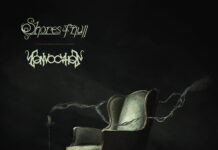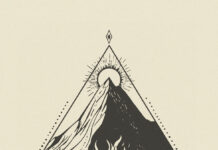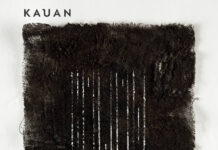POSEIDON is a musical entity born from the minds of Algol, active in bands such as HIEMS, FORGOTTEN TOMB, and KIRLIAN CAMERA; Argento, former frontman of Italian black metal act SPITE EXTREME WING, disbanded in 2008; and Azoth, former bassist in that very same band; their eponymous album will be published on February 28th, 2023, via Brucia Records. I could not even try to define which musical genre this album could fit in because it would be a losing battle and waste of time, but let’s proceed in order.

The project was named after the god of the sea in Greek mythology, as the whole concept was born and developed around sea-related suggestions. It was in late August, back in 2006, that Algol and Argento became deeply captivated by the place they were visiting: a very peculiar beach located on the island of Elba,Italy, called “le tombe,” [trans: the tombs], due to the black stones surrounding the site and the presence of ancient Etruscan graves. Such an evocative landscape had a big impact on Algol and Argento – the sound of the waves, repeating and compelling, inspired them to compose new music, largely based on improvisation, in order to catch those sensations of the cosmic bond between sea, land, and sky, in a never-ending flow. They immediately involved Azoth and started composing and recording music based on that intuition. Even though the sea has always been a source of inspiration for humankind in any form of artistic expression, POSEIDON takes a step further, since the sea itself, both as a real and a metaphorical entity, is likely to be considered as the main character in their narration.
The opening tune, “Aphros,” or “foam” in ancient Greek, is an instrumental track that portrays the sound of the waves as an intro and throughout the whole song; as hypnotic as the gentle lull of the currents, it develops in a repetitive circular melody provided by an acoustic guitar and later joined by bass. The second part is more ethereal and atmospheric, where a percussive element adds some further depth. The evocative power of the outcome really does drag the listener into a previously unknown dimension. As for the following tune, “On the Cave of the Nymphs,” a ritualistic vibe provided by percussions and guitars in a repetitive, yet ever-changing melody gives an accurate idea of the deep connection with nature and their inner selves the authors have experienced on that very night. In this regard, one feature that makes this album one-of-a-kind is its undisputed timelessness: conceived spontaneously almost 17 years ago, it is seeing the light only now, as the reflection of an inner journey that has neither a beginning nor an end.
A strong experimental approach is detectable on “Metamorphosis,” the shortest tune on the album. It is a live in studio recording, the outcome of improvisation, as can be heard in its unpredictable and weird structure. This is, in my opinion, the most difficult tune they wrote, but it surely makes the opus stand out in terms of richness and complexity in a good way.
“The Flying Dutchman,” whose title is a clear reference to the ghost ship, is a nice treat to anyone who is familiar with SPITE EXTREME WING, as it is a different version of “VIII” on the band’s very last album, “Ultra,” released back in 2008. Unlike the other songs on “Poseidon,” it does have lyrics, brilliantly written and recited by Algol, in poetic Italian, and he also took care of its mixing. It is worth the effort to share a rough translation of a couple of verses: “And for you, old vessel, roaming unknown courses, there is no harbor nor rest. Your fate is fading in the never-ending night, driven and doomed by a blind billow. I look up at prow. It is now dawning. Waiting for the first wave…”
Its neofolk vibe and iconic bassline make it quite accessible, but solemn and unconventional at the same time. A reference to POSEIDON as a band is visible in the booklet for “Ultra,” regarding this specific song, and it likely feels kind of strange to anyone who is still listening to that album with a certain nostalgia, but it also feels great to see these people release new-yet-old music again.
The following track, “Ci vuole un legno or Le Radeau de la Méduse,” sees Void on bass, who happens to be the owner of Brucia Records, and a long-time friend of the band members. It takes inspiration from the oil painting, The Raft of the Medusa, by French romantic painter Théodore Géricault, based on a shipwreck that happened in 1816, which led the victims to resort to cannibalism in order to survive. The first part of the title is taken from a famous Italian nursery rhyme, but since it can be translated to “it takes wood,” it can be connected to the main topic: a piece of wood is, in fact, what it takes to keep the pieces of a raft conveniently together. The dissonant and disturbing bass sound conveys perfectly a suffocating feeling of estrangement and altered state of consciousness, as the aftermath of days and days adrift.
Second-to-last “Opalescence 101” is an explicit reference to the optical phenomenon Argento and Algol had witnessed at Le Tombe beach on that night: the light of the moon reflected on the surrounding black serpentine stones gave an opalescent-ish effect as a result, as also can be seen in the album cover. The tune sounds much simpler if compared to the other tracks, but has a strong evocative vibe due to its repetitive and catchy pace. Algol took again the role of the narrator, as he recites some sea-inspired verses taken from Kahlil Gibran’s The Prophet.
As a closing tune, “A Saturno” does leave the listener in an undefined state of mind: it is equally fascinating and cryptic, as much as the sea in its numerous features. As already stated, there is no chance to pigeonhole such an opus, as its multifaceted nature is its most distinctive characteristic.
POSEIDON’s album goes beyond music and proves that the people involved do really know how to translate their unique and personal insights and emotions into an enigmatic and compelling piece of art where curiosity, an overwhelming creative urge, and deep self-knowledge work unanimously. Last but not least, the band has also encouraged their listeners to make the ritualistic creative process their own, as the CD version comes with a notebook meant to turn into some sort of a logbook: by following the instructions, the observers can go beyond the “mere” passive role of listeners and become involved, while experiencing POSEIDON in creating their own artistic ritual.

Written by Licia Mapelli
Tracklist
- Aphros
- On the Cave of the Nymphs
- Metamorphosis
- The Flying Dutchman (Algol mix)
- Ci vuole un legno or Le Radeau de la Méduse
- Opalescence 101
- A Saturno
Lineup
Argento – guitars, tube radio, mantra samples
Algol – guitars, percussions, vocals, sea samples
Azoth – bass, keys
Label
Brucia Records





